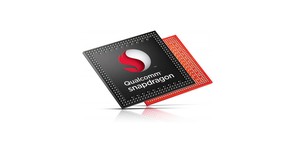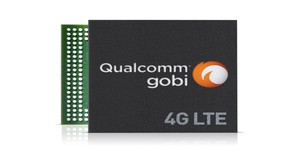
Qualcomm has announced that it fancies a slice of the burgeoning virtual reality pie, launching a development kit powered by its Snapdragon 835 system-on-chip (SoC) and featuring built-in eye-tracking capabilities, and it claims OEM versions will hit the market by the end of the year.
Designed to encourage companies to develop applications for upcoming Snapdragon-powered standalone virtual reality headsets, the specifications of Qualcomm's early-access development kit are pretty impressive. The headset features a 2,650x1,440 WQHD AMOLED display, six degrees of freedom (6DoF) motion tracking through two monochromatic megapixel cameras and the Snapdragon 835's built-in inertial measurement unit (IMU), eye tracking via two monochromatic VGA-resolution global shutter cameras, 64GB of UFS high-speed storage, and 4GB of LPDDR4 memory, in addition to the 2.45GHz eight-core CPU and Adreno 540 GPU that makes up the bulk of the Snapdragon 835 itself. Network connectivity is provided by Wi-Fi and Bluetooth radios, while a USB 3.1 Type-C connector powers the headset.
'With this new VRDK [Virtual Reality Developers Kit], we’re providing virtual reality application developers with advanced tools and technologies to accelerate a new generation of VR games, 360-degree VR videos and a variety of interactive education, enterprise, healthcare and entertainment applications,' claimed Cristiano Amon, executive vice president of Qualcomm Technologies, at the unveiling. 'We see great potential for the exciting new experiences made possible by truly mobile, untethered virtual reality that’s always connected to the internet, and we’re excited to help mobile VR developers more efficiently deliver compelling and high-quality experiences on upcoming Snapdragon 835 VR-capable products.'
According to Qualcomm, the software bundled with the headset includes a number of enhancements as well: data from the Snapdragon's sensor core is proceed by the on-board Hexagon digital signal processor (DSP) automatically with the best positioning data being fed back to the application, data from the eye-tracking system is fed to an automatic foveated rendering plugin for the Unity and Unreal game engines to provide maximum image clarity at the centre of the user's gaze, an improved asynchronous timewarp system with single-buffer rendering drops latency by 20 percent compared to the company's previous best efforts, and the software includes advanced application profiling and power management - key features for a mobile VR solution.
Qualcomm has said that it will make the development kit version available to Qualcomm Developer Network members some time in the second quarter of the year, but it appears to have no plans to bring the device to retail markets; instead, the company has teased 'upcoming VR OEM [Original Equipment Manufacturer] devices built with the Snapdragon 835 that are expected to ship in the second half of 2017' without naming any names.
Designed to encourage companies to develop applications for upcoming Snapdragon-powered standalone virtual reality headsets, the specifications of Qualcomm's early-access development kit are pretty impressive. The headset features a 2,650x1,440 WQHD AMOLED display, six degrees of freedom (6DoF) motion tracking through two monochromatic megapixel cameras and the Snapdragon 835's built-in inertial measurement unit (IMU), eye tracking via two monochromatic VGA-resolution global shutter cameras, 64GB of UFS high-speed storage, and 4GB of LPDDR4 memory, in addition to the 2.45GHz eight-core CPU and Adreno 540 GPU that makes up the bulk of the Snapdragon 835 itself. Network connectivity is provided by Wi-Fi and Bluetooth radios, while a USB 3.1 Type-C connector powers the headset.
'With this new VRDK [Virtual Reality Developers Kit], we’re providing virtual reality application developers with advanced tools and technologies to accelerate a new generation of VR games, 360-degree VR videos and a variety of interactive education, enterprise, healthcare and entertainment applications,' claimed Cristiano Amon, executive vice president of Qualcomm Technologies, at the unveiling. 'We see great potential for the exciting new experiences made possible by truly mobile, untethered virtual reality that’s always connected to the internet, and we’re excited to help mobile VR developers more efficiently deliver compelling and high-quality experiences on upcoming Snapdragon 835 VR-capable products.'
According to Qualcomm, the software bundled with the headset includes a number of enhancements as well: data from the Snapdragon's sensor core is proceed by the on-board Hexagon digital signal processor (DSP) automatically with the best positioning data being fed back to the application, data from the eye-tracking system is fed to an automatic foveated rendering plugin for the Unity and Unreal game engines to provide maximum image clarity at the centre of the user's gaze, an improved asynchronous timewarp system with single-buffer rendering drops latency by 20 percent compared to the company's previous best efforts, and the software includes advanced application profiling and power management - key features for a mobile VR solution.
Qualcomm has said that it will make the development kit version available to Qualcomm Developer Network members some time in the second quarter of the year, but it appears to have no plans to bring the device to retail markets; instead, the company has teased 'upcoming VR OEM [Original Equipment Manufacturer] devices built with the Snapdragon 835 that are expected to ship in the second half of 2017' without naming any names.

MSI MPG Velox 100R Chassis Review
October 14 2021 | 15:04








Want to comment? Please log in.